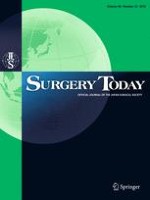01-12-2018 | Original Article
High intramuscular adipose tissue content as a precondition of sarcopenia in patients with aortic aneurysm
Published in: Surgery Today | Issue 12/2018
Login to get accessAbstract
Purpose
Sarcopenia is a major problem of the elderly. Although little is known about the cause of sarcopenia, the intramuscular adipose tissue content (IMAC) is known to be a cause of sarcopenia. The aim of this study was to investigate the significance of IMAC as a cause of sarcopenia.
Methods
We evaluated patients who underwent aneurysm repair and were monitored preoperatively and 3 years postoperatively by computed tomography (CT). The skeletal muscle area and IMAC were measured on preoperative L3 CT images. The clinical characteristics and risk factors for skeletal muscle wasting were assessed.
Results
Among the 155 patients, 38 (24.5%) had > 10% skeletal muscle wasting 3 years after the operation. Patients with > 10% skeletal muscle wasting had higher IMACs of the iliopsoas (− 0.31 ± 0.01 vs. −0.45 ± 0.01, P < 0.001) muscles and higher rates of cerebrovascular infarctions (7.7 vs. 23.7%, P = 0.0068), lung cancer (0 vs. 10.5%, P < 0.001), and urgent operations (0.9 vs. 10.5%, P = 0.029) and a longer postoperative fasting period (1.3 ± 0.1 vs. 3.1 ± 0.9 days, P < 0.001) than those without > 10% skeletal muscle wasting. The IMAC of the iliopsoas muscle correlated strongly with skeletal muscle wasting (P < 0.05, r = 0.70).
Conclusions
A high IMAC of the iliopsoas muscle may cause sarcopenia and thus be a clinical target in disease prevention.





